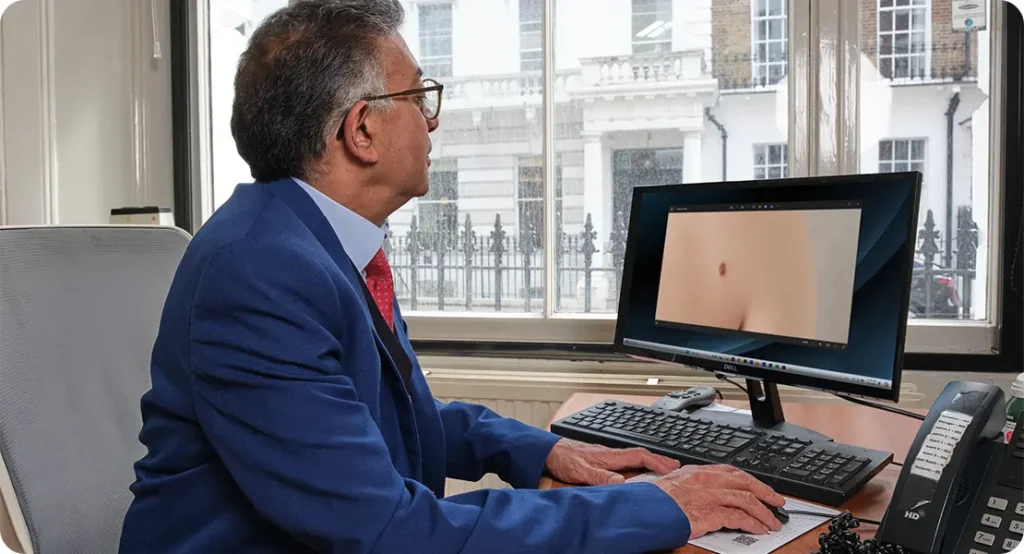Noticing small red spots on your skin can feel unsettling. For many of us, any unexpected change in our skin’s appearance immediately raises questions: Is this normal? Should I be worried? Do I need to see a doctor right away? These concerns are completely valid, especially if the spots show up suddenly, begin to spread, or don’t seem to fade over time.
The good news is that in a large number of cases, these little red marks often described as dots, patches, or pinpoint spots turn out to be harmless. They might be related to minor issues like broken capillaries, insect bites, or even simple skin irritation. However, it’s important not to dismiss them automatically, because in certain situations these red spots can be a signal of something more serious, such as an underlying medical condition or a skin disorder that needs professional attention.
That’s why understanding what could be behind these changes is so important. Being aware of the most common causes helps you feel more confident about whether you can manage the issue at home or whether it’s time to schedule an appointment with a dermatologist. In this article, I’ll guide you through the possible reasons why tiny red spots might appear, how to tell the difference between harmless and potentially concerning cases, and the signs that mean you should seek medical advice sooner rather than later.
It’s also worth remembering that our skin often acts as a mirror of our overall health. Changes that appear on the surface can sometimes reflect what’s happening inside the body. While tiny red spots may be nothing more than a cosmetic nuisance, they can occasionally point to issues such as allergies, infections, or even blood-related conditions. That doesn’t mean you need to panic at the first sign of a red dot, but paying attention to your skin and recognising when something looks unusual can make a real difference in catching problems early.
Common Causes of Tiny Red Spots

Red spots on the skin can develop for many different reasons, and not all of them are cause for alarm. Some are completely harmless and need no treatment, while others can be a sign of an underlying condition that may require attention from a healthcare professional. Understanding the possible causes can give you clarity and help you decide whether you need reassurance or medical advice. Here are some of the most common reasons why these tiny marks appear:
1. Cherry Angiomas
Cherry angiomas are among the most frequent culprits behind small red dots on the skin. These are benign (non-cancerous) skin growths made up of clusters of tiny blood vessels. They usually appear as bright red, smooth, dome-shaped spots that can range in size from a pinhead to a few millimetres across.
They often develop on the trunk, arms, or legs, although they can technically occur anywhere on the body. Cherry angiomas are especially common in adults over the age of 30, and the likelihood of developing them increases with age. While they are medically harmless, many people notice that they slowly increase in number over time.
Most of the time, no treatment is needed. However, some people choose to have them removed for cosmetic reasons, particularly if they appear on visible areas like the face or neck. Dermatologists can remove them safely using methods such as laser treatment, electrocautery, or cryotherapy.
2. Petechiae
Petechiae are another common reason for the sudden appearance of small red or purple dots. Unlike cherry angiomas, petechiae occur when tiny blood vessels under the skin (capillaries) break and cause pinpoint bleeding. These spots are usually flat and don’t blanch (fade) when you press on them, which helps distinguish them from other red skin marks.
Petechiae can appear after something as simple as vigorous coughing, sneezing, or physical strain. However, they can also be linked to certain medications, infections, or conditions that affect blood clotting. Because of this, it’s important not to ignore them especially if they appear suddenly in large clusters, spread quickly, or are accompanied by other symptoms like fever, fatigue, or unexplained bruising. In those cases, medical advice should be sought immediately.
3. Skin Irritation or Allergic Reactions
Your skin is your body’s first line of defence, which makes it highly responsive to irritants and allergens. Everyday triggers such as laundry detergents, new fabrics, skincare products, perfumes, or even jewellery can sometimes cause tiny red spots to appear. Insect bites or stings can also leave behind small, itchy, red marks.
In most cases, irritation-related spots are temporary. They may be itchy, slightly raised, or surrounded by mild swelling. Once the irritant or allergen is removed, the skin usually calms down within a few days. Over-the-counter antihistamines, soothing creams, or gentle moisturisers can also help reduce discomfort. However, if the reaction becomes more severe, or you notice swelling around the face or difficulty breathing, seek urgent medical attention as it could be a sign of a serious allergic reaction.
4. Heat Rash
Heat rash, also called miliaria, is a very common cause of tiny red bumps, especially in hot and humid environments. It happens when sweat ducts become blocked and trap sweat beneath the skin. The result is clusters of small, red or pink spots that may feel prickly or itchy.
This type of rash often develops in areas where sweat tends to accumulate, such as the back, chest, neck, or skin folds. Babies and young children are particularly prone to heat rash because their sweat ducts are still developing. Thankfully, heat rash is usually harmless and temporary. Allowing the skin to stay cool and dry, wearing lightweight clothing, and avoiding excessive sweating usually helps the rash disappear within a few days.
5. Other Skin Conditions
Finally, it’s important to remember that red spots can also be linked to other underlying skin conditions. For instance:
- Early stages of eczema may present as small red patches before developing into dry, itchy areas.
- Certain viral infections, such as chickenpox or measles, often begin with clusters of red spots or rashes.
- Even simple insect bites, like from mosquitoes or bedbugs, can appear as tiny red dots that sometimes resemble rashes.
The challenge with these conditions is that they often share overlapping symptoms. This is why dermatologists look not just at the appearance of the spots but also at their location, distribution, duration, and any accompanying signs like itching, pain, or fever. This full picture helps determine whether the spots are harmless or linked to something that requires treatment.
When to Worry

In many cases, red spots on the skin are completely harmless and may even disappear on their own. However, there are situations where paying close attention becomes essential. Knowing when to take action can help you avoid unnecessary anxiety while also ensuring that serious conditions aren’t overlooked. Here are some warning signs that should prompt you to seek professional advice:
- Spots that appear suddenly and spread quickly
If red dots show up all at once or begin to spread rapidly across different parts of your body, it’s a sign that something more than a simple irritation may be going on. Sudden onset rashes can sometimes be linked to infections, allergic reactions, or other systemic issues. - Non-blanching spots that do not fade when pressed
One of the easiest at-home checks you can do is to press lightly on a red spot. If it temporarily fades or lightens, it’s usually less concerning. However, if the spot does not fade at all what doctors call “non-blanching” it could be petechiae, which may point to issues with blood clotting or infection. This is a strong reason to consult a doctor promptly. - Spots accompanied by other symptoms
Red spots that come along with additional symptoms such as fever, fatigue, unexplained bruising, night sweats, or weight loss should never be ignored. These accompanying signs may indicate an underlying infection, an autoimmune condition, or a blood-related disorder. - Persistent or changing spots
While many skin spots resolve within a few days or weeks, any that linger for longer periods, change in appearance, increase in size, bleed easily, or become painful should be assessed by a dermatologist. These changes suggest that the spots are not simply cosmetic or temporary.
Ignoring these warning signs can sometimes delay the diagnosis of serious underlying conditions. It’s always better to err on the side of caution especially if you are unsure. A dermatologist can quickly assess whether your skin changes are harmless or require further testing and treatment.
How Dermatologists Diagnose Tiny Red Spots

When tiny red spots appear, it can be tempting to turn to online searches for answers. While general information can be useful, nothing replaces a professional evaluation by a dermatologist. These specialists are trained to distinguish between harmless skin changes and conditions that need medical attention. To do this, they usually follow a step-by-step process that combines careful observation with medical knowledge.
- Medical History
The first step is often a detailed discussion of your personal and family medical history. A dermatologist may ask questions about recent illnesses, infections, or fevers, as well as any medications or supplements you’re taking. They’ll also want to know if you have a history of allergies, skin sensitivities, or blood disorders. Even lifestyle factors such as your exposure to sunlight, skincare habits, diet, or level of stress can play a role in determining what might be behind the red spots. - Physical Examination
A close inspection of the skin itself comes next. Dermatologists look carefully at the colour, shape, and size of the spots, as well as their distribution across the body. They may also press gently on the spots to see whether they blanch (fade temporarily) or stay the same colour, as this gives important diagnostic clues. The texture of the spots whether they are flat, raised, smooth, or rough can also point towards different conditions. - Laboratory Tests
If the initial evaluation suggests that the spots could be linked to something more than a surface-level skin issue, blood tests or other lab investigations may be recommended. For example, blood work can reveal whether the spots are related to clotting abnormalities, infections, or immune system problems. In some cases, additional tests such as allergy panels or imaging studies may be considered to rule out specific causes. - Skin Biopsy
In rare situations where the diagnosis remains unclear, a skin biopsy might be performed. This involves taking a very small sample of the affected skin under local anaesthetic and examining it under a microscope. While the idea of a biopsy may sound intimidating, the procedure is quick, minimally invasive, and often provides the most accurate information about what’s happening at a cellular level.
This careful and systematic approach not only ensures that the correct diagnosis is made but also helps prevent unnecessary worry. Many red spots turn out to be harmless, and a dermatologist can provide reassurance, treatment options if needed, and guidance on how to manage or prevent future occurrences.
Treatment Options
The right treatment for tiny red spots on the skin depends entirely on their underlying cause. Since these spots can arise from a wide range of conditions some harmless and others more serious it’s important to match the treatment approach to the diagnosis. Here’s a closer look at how different causes are usually managed:
Cherry Angiomas: These are benign growths made up of small blood vessels. In most cases, they don’t need any medical treatment and can simply be left alone. However, some people choose to have them removed for cosmetic reasons, especially if they are in a visible area or if they tend to bleed when scratched. Removal options include laser therapy, electrocautery, or minor surgical excision, all of which can be done safely by a dermatologist.
Petechiae: Petechiae are pinpoint red or purple spots that may indicate issues such as infections, clotting problems, or side effects of certain medications. Treatment focuses on addressing the root cause. A doctor may recommend blood tests to rule out more serious conditions. In some cases, adjusting medication or starting treatment for an underlying illness can help clear up the spots.
Allergic Reactions: When red spots appear as part of an allergic reaction, the first step is to identify and avoid the trigger this might be a new skincare product, detergent, or certain foods. To ease the itching or irritation, topical antihistamines or mild corticosteroid creams are often prescribed. Severe reactions may require oral antihistamines or other medical treatment.
Heat Rash: Also known as prickly heat, this develops when sweat ducts become blocked, trapping perspiration under the skin. Treatment is usually simple and involves cooling the skin, keeping the affected area dry, and wearing loose, breathable clothing. Gentle skincare and avoiding heavy lotions can also help prevent further irritation.
Other Skin or Medical Conditions: In some cases, tiny red spots can be linked to more complex skin or systemic conditions. Here, treatment will be tailored specifically by a dermatologist or healthcare provider. This might involve prescription creams, oral medication, or a combination of therapies depending on the diagnosis.
Preventive Tips
Although not every cause of tiny red spots can be prevented, there are several steps you can take to lower your risk and keep your skin healthier overall. Small changes in daily habits, skincare routines, and lifestyle choices can go a long way in reducing irritation and flare-ups.
Choose Gentle Skincare Products
Your skin’s natural barrier is delicate, and harsh cleansers, soaps, or fragrances can easily trigger irritation or allergic reactions that show up as red spots. Opt for fragrance-free, hypoallergenic skincare products and patch test new items before using them regularly. Sticking to a simple routine with mild cleansers and soothing moisturisers helps protect the skin from unnecessary stress.
Avoid Common Irritants
Everyday products such as detergents, perfumes, or certain fabrics can cause skin irritation in sensitive individuals. If you notice a reaction after using something new, stop immediately and switch to alternatives designed for sensitive skin. Keeping a record of possible triggers can also make it easier to pinpoint what’s causing the problem.
Dress for the Weather
Heat rash is a common reason for small red spots, especially during hot and humid months. Wearing light, breathable clothing made from cotton or moisture-wicking fabrics can help your skin stay cool and dry. Avoiding tight, synthetic clothing reduces friction and prevents sweat from getting trapped under the skin.
Monitor Medications
Some medications can affect blood clotting or trigger skin reactions that lead to red spots, such as petechiae. If you’re prescribed long-term medication, make sure you’re aware of possible side effects. Never stop a prescribed treatment on your own, but speak with your doctor if you suspect a drug might be affecting your skin. They can adjust your dosage or suggest alternatives if necessary.
Maintain a Healthy Lifestyle
Your skin often reflects what’s happening inside your body. A balanced diet rich in vitamins, minerals, and antioxidants supports skin health and strengthens blood vessels. Staying well-hydrated helps your skin remain supple, while regular sleep and stress management keep your immune system functioning at its best. These healthy habits won’t prevent every case of red spots, but they will make your skin more resilient.
Regular Skin Checks
Finally, keep an eye on your skin. If you notice new spots appearing frequently, changing in appearance, or accompanied by other symptoms such as itching, pain, or bruising, it’s a good idea to get them checked by a dermatologist. Early attention helps rule out serious conditions and ensures you get the right treatment.
Final Thought: When to Seek Expert Help
Not every red spot is a cause for concern, but understanding the different possibilities is important. If you notice persistent, spreading, or unusual spots, it’s always best to get in touch with us to book a consultation with a dermatologist in London. Early evaluation ensures accurate diagnosis and effective treatment, giving you peace of mind and healthier skin.
References:
- Qadeer, H. A. (2023) ‘Cherry Hemangioma’, StatPearls. Available at: https://www.ncbi.nlm.nih.gov/books/NBK563207/
- Nazer, R. I. et al. (2020) ‘Cherry angioma: a case–control study’, Journal of Family and Community Medicine, 27(2), pp. 85–90. Available at: https://pubmed.ncbi.nlm.nih.gov/32831556/
- Wikipedia Contributors (2025) ‘Petechia’, Wikipedia. Available at: https://en.wikipedia.org/wiki/Petechia
- Pastor-Tomás, N. et al. (2023) ‘Clinical Relevance of Cherry Angiomas’, Actas Dermosifiliográficas. Available at: https://actasdermo.org/en-translated-article-clinical-relevance-cherry-articulo-S0001731023000479
- Al-Hattab, M. K. et al. (2024) ‘Evaluation of lipid profile in patients with cherry angioma: a case–control study in Iraqi patients’, Journal of Medical Biology, 2024. Available at: https://journals.lww.com/mjby/fulltext/2024/21010/evaluation_of_lipid_profile_in_patients_with.34.aspx
